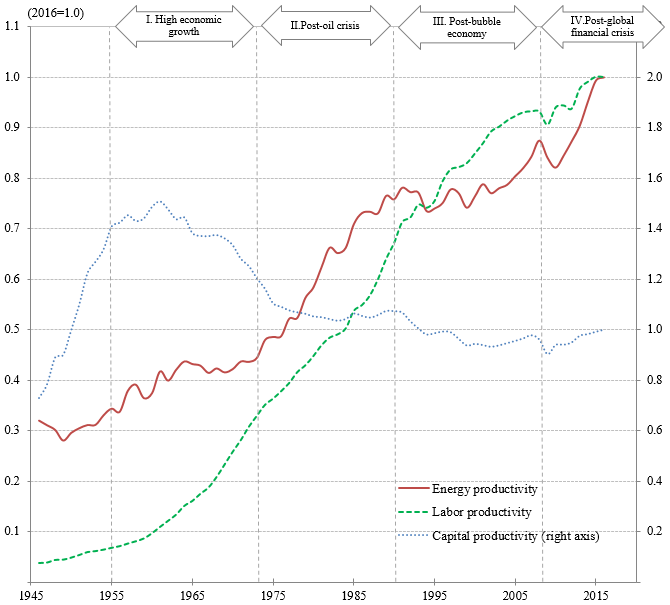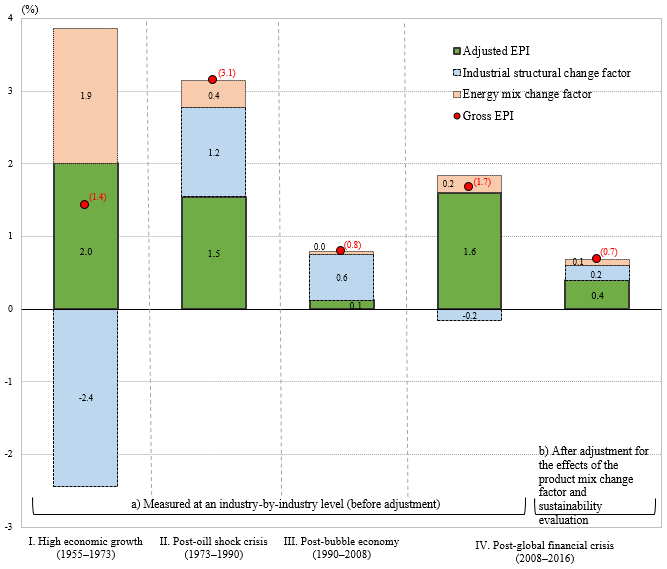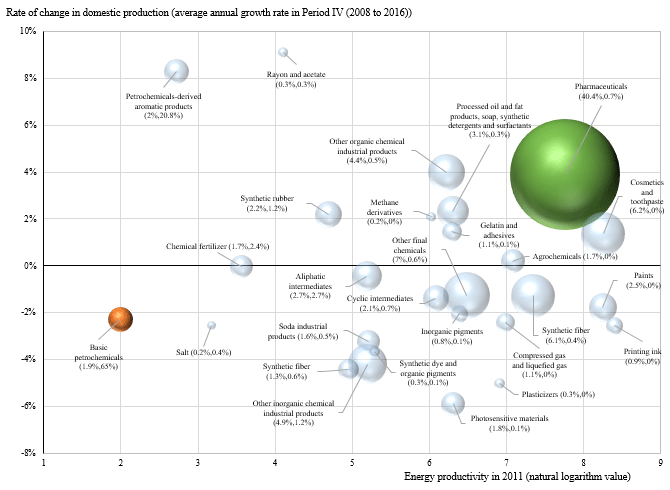In preparation for the G20 Summit that was held in Osaka in June 2019, the Long-Term Strategy under the Paris Agreement as A Growth Strategy was authorized by the cabinet on June 11. This strategy does little more than enumerate a wide-ranging set of goals that is lacking in consistency, but one element on which high expectations have been placed is the pursuit of energy productivity improvement (EPI) over the long term. The Japanese government (Ministry of Economy, Trade and Industry, 2015) has been proclaiming the goal of achieving a significant EPI rate of 35% between 2013 and 2030. This is comparable to the rate of EPI that the Japanese economy recorded in the wake of the oil crises, a period of time when the EPI initiative was in its prime. In Europe as well, there are high expectations that investment in EPI will strengthen, rather than undermine, the region's competitiveness, as indicated by the motto "Efficiency first" that is being proclaimed there (Cañete, 2015). Is it possible to achieve a dramatic EPI? If so, will that promote economic growth?
Continuous EPI at a Nationwide Level
In the Japanese economy, although energy productivity declined over the long term in the prewar period, it has consistently improved in the postwar period. Figure 1 shows a comparison of energy productivity, defined as real GDP per unit of primary energy consumption, with labor and capital productivity. The observation period is divided into four sections—Period I: High economic growth period (1955 to 1973); Period II: Post-oil crisis period (1973 to 1990); Period III. Post-bubble economy period (1990 to 2008); and Period IV: Post-global financial crisis period (2008 to 2016). Period II, during which two oil crises occurred, represented the pinnacle of EPI, when the average annual rate of EPI was 3.1%. While the steep rise in the crude oil price enhanced the rationality of investment in energy conservation and lowered capital productivity, the rate of EPI in Period II more than doubled compared with the rate in Period I (when the average annual rate of EPI was 1.4%).
However, the rates of EPI observed in these periods reflect the effects of various structural changes. First, EPI is affected by change in the industrial structure. Production volume in energy-intensive industries like steel and chemicals, which expanded significantly during the high economic growth period, declined in relative terms in the post-oil crisis period. This structural change causes the rate of EPI in Period I to be understated and the rate of EPI in Period II to be overstated.
Second, EPI is affected by changes in the energy mix. Generally speaking, the sophistication of the industrial structure is accompanied by electrification. If we assume that the heat efficiency of electricity generation is 30–50%, generation of a certain amount of electricity requires the input of primary energy with a heat quantity twice to three times as large as that of the electricity generated. This means that the advance of electrification causes the rate of EPI to be understated. Meanwhile, the improvement in heat efficiency and the qualitative improvement of energy service due to electrification cause the rate of EPI to be overstated. If we are to appropriately evaluate the input of energy, it is necessary to use an indicator that takes account of qualitative changes in the energy mix.

A Slowdown in EPI Revealed by Adjustment for Structural Changes
According to an analysis based on a newly developed long-term database that connects an industry-by-industry productivity account and an energy balance table for the purpose of adjustment for structural changes (Nomura, 2018), the rate of EPI in Period I (high economic growth period) is higher than the rate in Period II (post-oil crisis period), which was apparently the pinnacle of EPI (Figure 2). In Period I, real GDP in the steel and chemicals industries grew at an annual rate higher than 15% in response to robust investment demand. The annual rate of EPI for these two industries was also high, at around 5%. However, the annual rate of EPI at a nationwide level (gross EPI; before adjustment for the effects of structural changes), at 1.4%, is understated by 2.4 percentage points due to the effects of the structural change factor. On the other hand, although electrification advanced only slightly during this period, the rate of EPI was overstated by 1.9 percentage points due to the effects of improvement in heat efficiency (improvement on the side of electricity suppliers).

Meanwhile, in Period II, the annual rate of EPI, at 3.1%, was overstated by 1.2 percentage points due to the effects of a relative decline in the energy-intensive industries and by 0.4 percentage points due to the effects of the advance of electrification. If those effects were excluded, the adjusted annual rate of EPI comes to 1.5%, lower than the rate of 2.0% in Period I. The "intentional EPI" in Period II, which represented the results of efforts to counter the steep rise in crude oil prices, was smaller than the "unintentional EPI" in Period I, which was a consequence of the expansion of production capacity and investment for upgrades.
In Period III (post-bubble economy period), the adjusted annual rate of EPI was only 0.1%. During this period, both the public and private sectors stepped up energy conservation efforts, of which holding of the COP3 conference on global warming in Kyoto was a prime example. In the meantime, while the deflationary trend in Japan continued, energy prices remained high. Around the middle of 2008, the crude oil price was six times as high as the average in the late 1990s. Among the factors that caused the rate of EPI to decline steeply even in this environment are an increase in the marginal cost of achieving any additional EPI amid the saturation of energy conservation technologies available at low cost and the low level of investment for upgrades due to the slow growth of the Japanese economy.
Invisible Structural Changes at a Product-by-Product Level
Period IV (the post-global financial crisis period) became a major turning point. As shown by Figure 2, the adjusted annual rate of EPI rebounded to 1.6%, comparable to the rate of 1.5% in Period II. Around 60% of the EPI in that period is accounted for by improvements in the chemicals and steel industries. The annual rate of EPI for the chemicals industry slowed sharply to 0.9% in Period III from 5.0% in Period I and 4.1% in Period II, but it rebounded to 5.0% in Period IV. Was there still room for further spread of energy conservation technology?
To discover why the rate of EPI rebounded, it is necessary to conduct a more detailed analysis. Figure 3 shows the breakdown of EPI in the chemicals industry into product-by-product improvement. The horizontal axis signifies the energy productivity level, while the vertical axis signifies the growth rate of domestic production during the period. The size of each bubble corresponds to the amount of the value added. Let us focus on pharmaceuticals (located in the upper-right area of Figure 3) and basic petrochemicals (located in the lower-left area), which are two categories of chemical products with contrasting characteristics. From the viewpoint of value added, pharmaceuticals represent the largest category with a share of 40% of the entire chemical industry, while basic petrochemicals has a tiny share of slightly below 2%. Conversely, from the viewpoint of energy consumption, pharmaceuticals are responsible for less than 1%, while basic petrochemicals represent the largest category with a share of 65%. In Period IV, domestic production of pharmaceuticals grew at an annual rate of 4%, while that of basic petrochemicals recorded an annual decline of 2%. As a result, the rate of EPI in the chemicals industry in this period is overstated.

[Click to enlarge]
According to a preliminary calculation excluding the effects of change in the product mix within each industry and temporary factors such as the electricity saving initiative that followed the Great East Japan Earthquake, the adjusted annual rate of EPI falls to 0.4%, as shown in the far-right bar in Figure 2 ("b" in Period IV). Although preliminary calculations like this may include some elements of arbitrariness, the bottom line is that the rate of EPI measured at an industry-by-industry level is also highly likely to be overstated due to invisible structural changes occurring at a product-by-product level.
Conclusion-Pursuit of Gross EPI Could Undermine Growth Potential
Ever since the oil crises, promoting energy conservation has become a standard policy goal, and nearly half a century has passed since energy conservation started to be integrated into the work of governments around the world. Over the past 20 years in particular, the fight against global warming has become the focus of attention. While the cost burden is growing on the supply side due to the expansion of non-fossil power sources, such as nuclear and renewable energy, demand-side policy is becoming more and more restrictive.
However, if energy conservation standards become more rigorous at a time when the potential for spreading low-cost energy conservation technology further has been exhausted, that could only promote transfer of domestic production of energy-intensive products to other countries. In industries for which it is difficult to transfer production to other countries, it is inevitable that capital productivity will decline due to the need to procure high-cost, energy-efficient equipment or renovate existing facilities. This burden will offset the positive economic effects of EPI, undermining the overall economic efficiency (total factor productivity).
The experience of the Japanese economy suggests that the risk of the pursuit of EPI itself causing weakening growth potential is increasing. However, structural changes that may misrepresent EPI are statistically very difficult to identify, and this situation poses a high risk of inducing a misguided policy.


